Mapping New IOCG Mineral Systems in Brazil: The Vale do Curaçá and Riacho do Pontal Copper Districts
Abstract
1. Introduction
Purpose and Scope
2. Geologic Setting and Mineralization
2.1. Classification as IOCG Deposits
2.2. Palaeoproterozoic Vale do Curaçá Copper District
Geology of the Caraíba Mine
2.3. Geology of the Neoproterozoic Riacho do Pontal Copper District
3. Tectonic Setting
4. Data
4.1. Gravity and Magnetic Data
Gradient Functionals Calculated from the Magnetic Data
4.2. Petrophysical Data
4.3. Geologic Data
4.4. Seismic Tomography
5. Methods
5.1. 3D Magnetic and Gravity Inversion Models
5.2. 3D Magnetic Inversion
5.3. 3D Density Inversion
6. Results
6.1. Gravity and Magnetic Signatures
6.1.1. Vale do Curaçá District
6.1.2. Riacho Do Pontal Copper District
6.2. 3D Inversion Models
6.2.1. Vale do Curaçá Copper District
6.2.2. Riacho do Pontal District
7. Discussion
7.1. Vale do Curaçá and Riacho do Pontal District IOCG Mineral Systems
7.1.1. Lithospheric Setting Expressed by the Seismic Tomography Potential
7.1.2. Structural Control
7.1.3. Geophysical Implications for Alteration
8. Exploration Potential
- (a)
- Structural: increase in shearing intensity and in the density of structures in the direction of secondary structures. Foliation tends to be vertical. Regardless of the structural regime, most deposits in both districts are controlled by bends in the host rocks.
- (b)
- Stream sediment and soil: anomalies of Cu, Ni, Fe, and La in stream sediment and Cu (Ni, Ce and La) in soil.
- (c)
- Low magnetic anomalies related to Kd (Kd-anomalous potassium) and shear zones [24].
- (d)
- Low magnetic anomalies (abundant hematite related to ore zones).
- (a)
- The district of Vale do Curaçá is associated regionally with high gravimetric and magnetic anomalies corresponding with the portion west of the ISCO.
- (b)
- Our studied area is inboard of a relatively high velocity region, bordered eastwards by a low velocity region. The high-velocity region presumably indicates the cratonic area, with the lower velocity region demarcating the craton limit.
- (c)
- The Caraíba mine bodies are strongly related to magnetic and gravimetric NS trends interpreted to have susceptibility with >0.09 SI and density >0 g/cm3.
- (d)
- Increases in Fe actinolite FeOt/and Fe-biotite (towards more hydrothermalized altered zones (Figure 14).
9. Conclusions
- The Vale do Curaçá and Riacho do Pontal copper districts are hosted in distinct geological and tectonic settings, and an older IOCG mineralization event occurring within the São Francisco Craton is related to Palaeoproterozoic (ca 2 to 2.2 Ga) hydrothermal processes. A younger phase of IOCG mineralization in the Neoproterozoic (ca 750 to 570 Ma) has been recognized in the Brazilian mobile belt.
- Both IOCG districts developed in an arc tectonic setting [50] overprinted by strike slip shear zones.
- The interpretation of gravimetric and magnetic data shows different magnetic and gravimetric signatures for these two copper districts.
- The Vale do Curaçá copper district is in a high regional gravimetric domain. It is 110 km in length and 22 km in width and shows a strong relationship with magnetic and gravimetric anomalies. The Caraíba, Surubim, and Vermelhos mines and some copper occurrences are positioned at this site.
- The regional gravimetric signature of the Riacho do Pontal District is mainly related to a negative Bouguer NW–SE anomaly. This negative Bouguer anomaly represents the collisional suture between the cratonic block and mobile belt Riacho do Pontal. The IOCG occurrences of the Ria4 prospects are found in these low gravimetric signature domains. The rocks, slightly altered, have a density of 2.7–2.78 g/cm3, and the most heavily altered rocks show densities of 2.75–3.1 g/cm3.
- The magnetic signatures are quite distinct. Copper corridors in the Vale do Curaçá copper district are associated with magnetic anomalies located in the western portion of the Itabuna-Salvador-Curaçá orogen. On the other hand, the copper deposits located in the belt of the Riacho do Pontal district are situated in zones with or without very weak magnetic anomalies.
- MVI shows two main NNW prospective trends in the Vale do Curaça district. Trends I and II have a sigmoidal shear shape. These trends are positioned in the contact zone between domains with high magnetization (susceptibility > 0.005 SI) and density anomalies (>0 g/cm3) and show a contrast in density and magnetite content. Trend I is 40 km in length and 10 km in width. It hosts the Caraíba, Surubim, and Vermelho mines and other deposits and is the most important trend for hosting IOCG deposits in the district.
- The general hydrothermal zoning pattern for IOCG deposits is largely vertical from magnetite-dominant at depth to hematite-dominant in the upper levels. It is possible to interpret the Neoproterozoic Riacho do Pontal district as positioned in the shallowest portion of the IOCG system. Thus, additional work must be performed by searching for deeper (or more eroded) areas of the IOCG system related to more magnetic and dense areas (targets in the northern portion of the Riacho Seco target).
- Large areas flanking the high-velocity seismic tomography image that already control, on a broad scale, the Carajás IOCG province and Riacho do Pontal and Vale do Curaçá copper districts in Brazil should be evaluated in more detail in a further exploratory program.
Author Contributions
Funding
Acknowledgments
Conflicts of Interest
References
- Hayward, N.; Corriveau, L.; Craven, J.A.; Enkin, R.J. Geophysical signature of the NICO Au-Co-Bi-Cu deposit and its iron oxide-alkali alteration system, Northwest Territories, Canada. Econ. Geol. 2016, 111, 2087–2109. [Google Scholar] [CrossRef]
- Smith, R.J. Geophysics of iron oxide copper-gold deposits. In Hydrothermal Iron Oxide Copper-Gold and Related Deposits; Porter, T.M., Ed.; PGC Publishing: Adelaide, Australia, 2002; Volume 2, pp. 357–367. [Google Scholar]
- Clark, D.A.; Geuna, S.; Schmidt, P.W. Predictive Magnetic Exploration Models for Porphyry, Epithermal and Iron Oxide Copper-Gold Deposits: Implications for Exploration, and Mining: Commonwealth Scientific and Industrial Research Organization (CSIRO) Exploration and Mining Report. 2013. 1073R. Available online: https://confluence.csiro.au/download/attachments/26574957/Clark%20etal%202004%20P700%20CSIRO%201073Rs.pdf?version=2&modificationDate=1460597746010&api=v2 (accessed on 24 November 2020).
- Clark, D.A. Magnetic effects of hydrothermal alteration in porphyry copper and iron-oxide copper–gold systems: A review. Tectonophysics 2014, 624–625, 46–65. [Google Scholar] [CrossRef]
- Hitzman, M.W.; Oreskes, N.; Einaudi, M.T. Geological characteristics and tectonic setting of proterozoic iron oxide (CuUAuREE) deposits. Precambrian Res. 1992, 58, 241–287. [Google Scholar] [CrossRef]
- Pollard, P.J.; Taylor, R.G.; Peters, L.; Matos, F.; Freitas, C.; Saboia, L.; Huhn, S. 40Ar-39Ar dating of Archean iron oxide Cu-Au and Paleoproterozoic granite-related Cu-Au deposits in the Carajás Mineral Province, Brazil: Implications for genetic models. Miner. Deposita 2018, 54, 329–346. [Google Scholar] [CrossRef]
- Barton, M.D. Iron Oxide (-Cu-Au-REE-P-Ag-U-Co) Systems: Treatise on Geochemistry, 2nd ed.; 2014; Volume 13, pp. 515–541. Available online: https://doi.org/10.1016/B978-0-08-095975-7.01123-2 (accessed on 24 November 2020).
- Groves, D.I.; Bierlein, F.P.; Meinert, L.D.; Hitzman, M.W. Iron oxide copper-gold (IOCG) deposits through earth history: Implications for origin, lithospheric setting, and distinction from other epigenetic iron oxide deposits. Econ. Geol. 2010, 105, 641–654. [Google Scholar] [CrossRef]
- O’Driscoll, E.S.T. The application of lineament tectonics to the discovery of the Olympic Dam Cu-Au-U deposit at Roxby Downs, South Australia. Glob. Tecton. Metallog. 1985, 3, 43–57. [Google Scholar]
- Hitzman, M.W. Iron oxide-Cu-Au deposits: What, where, when, and why. In Hydrothermal Iron Oxide Copper-Gold and Related Deposits: A Global Perspective; Porter, T.M., Ed.; Australian Mineral Foundation: Adelaide, Australia, 2000; pp. 9–25. [Google Scholar]
- Groves, D.I.; Goldfarb, R.J.; Santosh, M. The conjunction of factors that lead to formation of giant gold provinces and deposits in non-arc settings. Geosci. Front. 2016, 7, 303–314. [Google Scholar] [CrossRef]
- Hühn, S.R.B.; Nascimento, J.A.S. São os depósitos cupríferos de Carajás do tipo Cu-Au-U-ETR? In Contribuições à Geologia da Amazônia; Costa, M.L., Angélica, R.S., Eds.; FINEP.SBG-NO: Belém, Brazil, 1997; pp. 143–160. [Google Scholar]
- Lindenmayer, Z.G. Evolução geológica do Vale do Rio Curaçá e dos corpos máfico-ultramáficos mineralizados a cobre (Orgs.). In Geologia e Recursos Minerais do Estado da Bahia: Textos básicos; Inda, H.A.V., Marinho, M.M., Duarte, F.B., Eds.; SME: Salvador, Brazil, 1981; Volume 4, pp. 72–110. [Google Scholar]
- Lindenmayer, Z.G. Evolução Geológica do Vale do rio Curaçá e dos Corpos Máfico-Ultramáficos Mineralizados a Cobre. Master’s Thesis, Universidade Federal da Bahia, Salvador, Brazil, 1982. [Google Scholar]
- Requia, K.; Stein, H.; Chiaradia, M. Re-Os and Pb-Pb geochronology of the Archean Salobo iron oxide copper?gold deposit, Carajás mineral province, northern Brazil. Miner. Depos. 2007, 38, 727–738. [Google Scholar] [CrossRef]
- Tallarico, F.H.B.; Figueiredo, B.R.; Groves, D.I.; Kositcin, N.; McNaughton, N.J.; Fletcher, I.R.; Rego, J.L. Geology and shrimp U-Pb geochronology of the igarape bahia deposit, carajas copper-gold belt, Brazil: An Archean (2.57 Ga) Example of Iron-Oxide Cu-Au-(U-REE) Mineralization. Econ. Geol. 2005, 100, 7–28. [Google Scholar] [CrossRef]
- Dreher, A.M.; Xavier, R.P.; Taylor, B.E.; Martini, S.L. New geologic, fluid inclusion and stable isotope studies on the controversial Igarapé Bahia Cu–Au deposit, Carajás Province, Brazil. Miner. Depos. 2008, 43, 161–184. [Google Scholar] [CrossRef]
- Monteiro, L.V.S.; Xavier, R.P.; De Carvalho, E.R.; Hitzman, M.W.; Johnson, C.A.; Filho, C.R.D.S.; Torresi, I. Spatial and temporal zoning of hydrothermal alteration and mineralization in the Sossego iron oxide–copper–gold deposit, Carajás Mineral Province, Brazil: Paragenesis and stable isotope constraints. Miner. Depos. 2008, 43, 129–159. [Google Scholar] [CrossRef]
- Monteiro, L.V.S.; Caetano, J.; Souza, C.R.; Carvalho, E.R.; Hitzman, M.W. Mineral chemistry of ore and hydrothermal alteration at the Sossego iron oxide-copper-gold deposit, Carajás Mineral Province, Brazil. Ore Geol. Rev. 2008, 34, 317–336. [Google Scholar] [CrossRef]
- Teixeira, J.B.G.; Silva, M.D.G.D.; Misi, A.; Cruz, S.C.P.; Sá, J.H.D.S. Geotectonic setting and metallogeny of the northern São Francisco craton, Bahia, Brazil. J. S. Am. Earth Sci. 2010, 30, 71–83. [Google Scholar] [CrossRef]
- Xavier, R.P.; Rusk, B.; Emsbo, P.; Monteiro, L.V.S. Composition and source of salinity of ore-bearing fluids in Cu-Au systems of the Carajás Mineral Province, Brazil. In Proceedings of the 10th biennial meeting of the SGA, Townsville, Australia, 17–20 August 2009; Volume 1, pp. 272–274. [Google Scholar]
- Xavier, R.P.; Monteiro, L.V.S.; Souza Filho, C.R.; Torresi, I.; Carvalho, E.R.; Dreher, A.M.; Wiedenbeck, M.; Trumbull, R.B.; Pestilho, A.L.S.; Moreto, C.P.N. The iron oxide copper-gold deposits of the Carajás Mineral Province, Brazil: An updated and critical review. In Hydrothermal Iron Oxide Copper-Gold and Related Deposits: A Global Perspective, v3—Advances in Understanding of IOCG Deposits; Porter, T.M., Ed.; PGC Publishing: Adelaide, Australia, 2010; pp. 285–306. [Google Scholar]
- DeMelo, G.H.C.; Monteiro, L.V.S.; Xavier, R.P.; Moreto, C.P.N.; Santiago, E.S.B.; Dufrane, S.A.; Aires, B.; Santos, A.F.F. Temporal evolution of the giant Salobo IOCG deposit, Carajás Province (Brazil): Constraints from paragenesis of hydrothermal alteration and U-Pb geochronology. Miner. Depos. 2016, 52, 709–732. [Google Scholar] [CrossRef]
- Hühn, S.R.B.; Silva, A.M. Favourability potential for IOCG type of deposits in the Riacho do Pontal Belt: New insights for identifying prospects of IOCG type deposits in NE Brazil. Braz. J. Geol. 2018, 48, 703–771. [Google Scholar] [CrossRef]
- Holdsworth, R.; Pinheiro, R.V. The anatomy of shallow-crustal transpressional structures: Insights from the Archaean Carajás fault zone, Amazon, Brazil. J. Struct. Geol. 2000, 22, 1105–1123. [Google Scholar] [CrossRef]
- Teixeira, J.B.G.; Silva, M.G.; Lindenmayer, Z.G.; Silva D’el-Rey, L.J.H.; Vasconcelos, P.M.; Reis, C.H.C.; Andrade, J.B.F. Depósitos de cobre do Vale do Rio Curaçá, Bahia. In Modelos de Depósitos de Cobre do Brasil e Sua Resposta ao Intemperismo; Brito, R.S.C., Silva, M.G., Kyumjian, R.M., Eds.; CPRM: Brasília, Brazil, 2010; p. 190. [Google Scholar]
- Juliani, C.; Monteiro, L.V.; Fernandes, C.M.D. Potencial mineral: Cobre. In Recursos Mineral do Brasil: Problemas e Desafios; Academia Brasileira de Ciências: Rio de Janeiro, Brazil, 2016; pp. 134–153. [Google Scholar]
- Huhn, S.R.B.; Sousa, M.J.; Filho, C.R.D.S.; Monteiro, L.V.S. Geology of the Riacho do Pontal iron oxide copper-gold (IOCG) prospect, Bahia, Brazil: Hydrothermal alteration approached via hierarchical cluster analysis. Braz. J. Geol. 2014, 44, 309–324. [Google Scholar] [CrossRef]
- Garcia, P.M.D.P.; Teixeira, J.B.G.; Misi, A.; Sá, J.H.D.S.; Silva, M.D.G.D. Tectonic and metallogenic evolution of the Curaçá Valley Copper Province, Bahia, Brazil: A review based on new SHRIMP zircon U-Pb dating and sulfur isotope geochemistry. Ore Geol. Rev. 2018, 93, 361–381. [Google Scholar] [CrossRef]
- D’el-Rey, L.J.H.; Oliveira, J.G.; Gaal, E.G. Implication of the Caraíba deposit’s structural controls on the emplacement Brazilian. J. Geol. 1996, 2, 309–324. [Google Scholar]
- Delgado, L.M.; Souza, J.D. Projeto Cobre Curaçá. Cobre no Vale do Rio Curaçá, Estado da Bahia, Departamento Nacional de Produção Mineral, Seção Geologia Econômica; Geologia Econômica: Brasilia, Brazil, 1981; pp. 7–149. (In Portuguese) [Google Scholar]
- Mendonca, R.J. Updated Mineral Resources and Mineral Reserves Statements of Mineração Caraíba’s Vale do Curaçá Mineral Assets, Curaçá Valley; Curaca Technical Report: Bahia, Brazil, 2018; p. 284. Available online: https://www.miningdataonline.com/reports/Curaca_Technical_report_2018.pdf (accessed on 24 November 2020).
- Maier, W.D.; Barnes, S.J. The origin of Cu sulfide deposits at Curaçá Valley, Bahia, Brazil: Evidence from Cu, Ni, Se and platinum—Group element concentrations. Econ. Geol. 1999, 2, 165. [Google Scholar] [CrossRef]
- Rocha, A.M.R. Metassomatismo Hidrotermal e Controle da Mineralização Aurífera na Área da Mina Futura, depósito de Caraíba, Bahia. Ph.D. Thesis, Universidade Federal do Rio Grande do Norte, Natal, Brazil, 1999. [Google Scholar]
- Companhia Baiana De Pesquisa Minerais—CBPM. Informações Geológicas e de Recursos Minerais do Estado da Bahia. 2011. Available online: http://www.cbpm.com.br/igba (accessed on 24 November 2020).
- Garcia, P.M.P. Metalogênese dos depósitos cupríferos de Caraíba, Surubim, Vermelhos e Sussuarana, Vale do Curaçá, Bahia, Brasil. Master’s Thesis, Universidade Federal da Bahia, Salvador, Brazil, 2013. [Google Scholar]
- Franklin, J.M.; Lydon, J.W.; Sangster, D.F. Volcanic associated massive sulfide deposits. In Economic Geology, 75th Anniversary Volume; Society of Economic Geologists: Denver, CO, USA, 1981; pp. 485–627. [Google Scholar]
- Barrie, C.T.; Hannington, M.D. Introduction: Classification of VMS deposits based on host rock composition. In Volcanic-associated massive sulfide deposits: Processes and Examples in Modern and Ancient Settings. Reviews in Economic Geology, n.8; Society of Economic Geologists: Denver, CO, USA, 1999; pp. 2–10. [Google Scholar]
- Delgado, L.M.; Sousa, J.D.; Projeto Cobre Curaçá. Geologia Econômica do Distrito Cuprífero do Rio Curaçá. In Relatório Final; CPRM: Salvador/Bahia, Brazil, 1975. Available online: http://rigeo.cprm.gov.br/jspui/handle/doc/8838 (accessed on 24 November 2020).
- Fraguas, S. Evolução da Mina Caraíba, Bahia. In Simexmin: Novos Casos de Sucesso em Exploração Mineral e Desenvolvimento de Minas no Brasil; CD-ROM, V Simpósio Brasileiro de Exploração Mineral (Simexmin): Ouro Preto/MG, Brazil, 2012. [Google Scholar]
- Barbosa, J.S.F. The Granulites of the Jequié Complex and Atlantic Coast Mobile Belt, Southern Bahia, Brazil—An Expression of Archean/Early Proterozoic Plate Convergence; Springer: Dordrecht, The Netherlands, 1990; pp. 195–221. Available online: https://link.springer.com/chapter/10.1007/978-94-009-2055-2_11 (accessed on 24 November 2020).
- Barbosa, J.S.F.; Dominguez, J.M.L. (Eds.) Geologia da Bahia: Texto Explicativo; SGM: Salvador, Brazil, 1996; p. 400. [Google Scholar]
- Padilha, A.V.; Melo, R.C. 8th Chapter. Evolução Geológica. In PLGB. Pintadas. Folha SC-24-Y-D-V. Texto Explicativo; Melo, R.C., Ed.; Escala 1:100.000. DNPM: Brasília, Brazil, 1991; pp. 129–157. [Google Scholar]
- Barbosa, J.; Sabaté, P. Archean and Paleoproterozoic crust of the São Francisco Craton, Bahia, Brazil: Geodynamic features. Precambrian Res. 2004, 133, 1–27. [Google Scholar] [CrossRef]
- Oliveira, E.P.; Windley, B.F.; McNaughton, N.J.; Pimental, M.; Fletcher, I.R. Contrasting copper and chromium metallogenic evolution of terranes in the Paleoproterozoic Itabuna-Salvador-Curaçá orogen, São Francisco Craton, Brazil: New zircon (SHRIMP) and SmeNd (model) ages and their significance for orogen-parallel escape tectonics. Precambrian Res. 2004, 128, 143–165. [Google Scholar] [CrossRef]
- D’el-Rey, J.H.; Dantas, E.L.; Teixeira, J.B.G.; Laux, J.H.; Silva, M.G. U–Pb and Sm–Nd geochronology of amphibolites from the Curaçá Belt, São Francisco Craton, Brazil: Tectonic implications. Gondwana Res. 2007, 12, 454–467. [Google Scholar] [CrossRef]
- Alves da Silva, F.C.; Chauvet, A.; Faure, M. Thrusting, wrench-type tectonics and granite emplacement during an early Proterozoic Basin closure: The example of the Itapecuru greenstone belt NE-Brasil. In Anais II Simp. Geol. do Cráton do São Francisco; Salvador. Soc. Bras. Geol: Núcleo Bahia/Sergipe, Brazil; pp. 63–66.
- D’el-Rey, L.J.H. Geologia e controle estrutural do depósito cuprífero Caraíba, Vale do Curaçá, Bahia. Geologia e Recursos Naturais do Estado da Bahia, SME, 1985. Série Textos Básicos 1985, 6, 51–123. [Google Scholar]
- Alkmin, F.F.; Brito Neves, B.; Castro, J.A. Arcabouço tectônico do Cráton São Francisco: Uma revisão. In O Cráton do São Francisco; Domingues, J.M.L., Misi, A., Eds.; SBG/SGM/CNPq: Salvador, Brazil, 1993; pp. 45–62. [Google Scholar]
- Oliveira, R.G. Arcabouço geofísico, isostasia e causas do magmatismo cenozóico da Província Borborema e de sua margem continental (nordeste do Brasil). Ph.D. Thesis, Universidade Federal do Rio Grande do Norte, Natal, Brazil, 2008. [Google Scholar]
- Jardim de Sá, E.F. A Faixa Seridó (Província Borborema, NE do Brasil) e o seu significado geodinâmico na Cadeia Brasiliana/Pan-Africana. Ph.D. Thesis, Universidade de Brasília, Brasília, Brazil, 1994; 803p. [Google Scholar]
- Jardim de Sá, E.F.; Macedo, M.H.F.; Fuck, R.A. Terrenos proterozóicos na Província Borborema e a margem norte do Cráton São Francisco. Rev. Bras. Geociências 1992, 4, 472–480. [Google Scholar]
- Gray, D.R.; Foster, D.A.; Meert, J.G.; Goscombe, B.D.; Armstrong, R.; Trouw, R.A.J.; Passchier, C.W. A Damara orogen perspective on the assembly of southwestern Gondwana. In West Gondwana: Pre-cenozoic Correlations across the South Atlantic Region; Pankhurst, R.J., Ed.; Geological Society Special Publications: London, UK, 2008; p. 294. [Google Scholar]
- Liégeois, J.-P.; Stern, R.J. Sr–Nd isotopes and geochemistry of granite-gneiss complexes from the Meatiq and Hafafit domes, Eastern Desert, Egypt: No evidence for pre-Neoproterozoic crust. J. Afr. Earth Sci. 2010, 57, 31–40. [Google Scholar] [CrossRef]
- Neves, B.B.D.B.; Fuck, R.A. The basement of the South American platform: Half Laurentian (N-NW)+half Gondwanan (E-SE) domains. Precambrian Res. 2014, 244, 75–86. [Google Scholar] [CrossRef]
- De Araujo, C.E.G.; Rubatto, D.; Hermann, J.; Cordani, U.G.; Caby, R.; Basei, M.A.S. Ediacaran 2500-km-long synchronous deep continental subduction in the West Gondwana Orogen. Nat. Commun. 2014, 5, 5198. [Google Scholar] [CrossRef]
- Ganade, C.E.; Cordani, U.G.; Agbossoumounde, Y.; Caby, R.; Basei, M.A.S.; Weinberg, R.F.; Sato, K. Tightening-up NE Brazil and NW Africa connections: New U–Pb/Lu–Hf zircon data of a complete plate tectonic cycle in the Dahomey belt of the West Gondwana Orogen in Togo and Benin. Precambrian Res. 2016, 276, 24–42. [Google Scholar] [CrossRef]
- Grainger, C.J.; Groves, D.I.; Tallarico, F.H.; Fletcher, I.R. Metallogenesis of the Carajás Mineral Province, Southern Amazon Craton, Brazil: Varying styles of Archean through Paleoproterozoic to Neoproterozoic base- and precious-metal mineralisation. Ore Geol. Rev. 2008, 33, 451–489. [Google Scholar] [CrossRef]
- Companhia Baiana De Pesquisa Minerais—CBPM. Levantamento aerogeofísico Projeto Riacho Seco Andorinhas; Companhia Baiana De Pesquisa Minerais—CBPM: Salvador, Brazil, 2001; 80p. [Google Scholar]
- Reid, A.B. Aeromagetic survey design. Geophysics 1980, 15, 973–976. [Google Scholar] [CrossRef]
- Ferreira, F.J.F.; De Souza, J.; Bongiolo, A.D.B.E.S.; De Castro, L.G. Enhancement of the total horizontal gradient of magnetic anomalies using the tilt angle. Geophysics 2013, 78, 33–41. [Google Scholar] [CrossRef]
- Thompson, D.T. EULDPH: A new technique for making computer-assisted depth estimates from magnetic data. Geophysics 1982, 47, 31–37. [Google Scholar] [CrossRef]
- Hinze, W.J.; von Frese, R.R.B.; Saad, A.H. Gravity and Magnetic Exploration: Principles, Practices, and Applications; Cambridge University Press: Cambridge, UK, 2013. [Google Scholar]
- Begg, G.C.; Griffin, W.L.; Natapov, L.M.; O’Reilly, S.Y.; Grand, S.; O’Neill, C.J.; Poudjom Djomani, Y.; Deen, T.; Bowden, P. The lithospheric architecture of Africa: Seismic tomography, mantle petrology and tectonic evolution. Geosphere 2009, 5, 23–50. [Google Scholar] [CrossRef]
- Begg, G.C.; Ronsky, A.M.H.; Arndt, N.T.; Griffin, W.L.G.; O’Reilly, S.Y.; Hayward, N. Lithospheric, cratonic and geodynamic setting of Ni-Cu-PGE sulphide deposits. Econ. Geol. 2010, 105, 1057–1070. [Google Scholar] [CrossRef]
- Griffin, W.L.; Begg, G.C.; O’Reilly, S.Y. Continental-root control on the genesis of magmatic ore deposits. Nat. Geosci. 2013, 6, 905–910. [Google Scholar] [CrossRef]
- Macleod, I.N.; Ellis, R.G. Magnetic Vector Inversion, a Simple Approach to the Challenge of Varying Direction of Rock Magnetization; Australian Society of Exploration Geophysicists, Extended Abstracts: Melbourne, Australia, 2013; pp. 1–4. [Google Scholar]
- Telford, W.M.; Geldart, L.P.; Sheriff, R.E. Applied Geophysics, 2nd ed.; Cambridge University Press: Cambridge, UK, 1990. [Google Scholar]
- Ellis, R.G.; de MacLeod, W.B. Inversion of Magnetic Data for Remanent and Induced Sources. ASEG Extended Abstracts. 2012, pp. 1–4. Available online: https://doi.org/10.1071/ASEG2012ab117 (accessed on 24 November 2020).
- Oliveira, R.G.; Medeiros, V.C. Contrastes geofísicos e heterogeneidade crustal do terreno Pernambuco-Alagoas, Província Borborema, NE Brasil. In SBG-Núcleo Nordeste. Simpósio de Geologia do Nordeste. 17; Boletim: Recife, Brazil, 2000; Volume 16, p. 176. [Google Scholar]
- Corriveau, L.; Mumin, A.H.; Setterfield, T. IOCG environments in Canada: Characteristics, geological vectors to ore and challenges. In Hydrothermal Iron Oxide Copper-Gold & Related Deposits: A Global Perspective; Porter, T.M., Ed.; Porter Geoscience Consultancy Publishing: Adelaide, Australia, 2010; Volume 4, pp. 311–344. [Google Scholar]
- Potter, E.G.; Corriveau, L.; Kerswill, J.K. Potential for iron oxide-copper–gold and affiliated deposits in the proposed national park area of the East Arm, Northwest Territories: Insights from the Great Bear magmatic zone and global analogs. In Mineral and Energy Resource Assessment for the Proposed Thaidene Nene National Park Reserve, East Arm of Great Slave Lake, Northwest Territories; Wright, D.F., Ed.; Open File 7196; Geological Survey of Canada: Ottawa, ON, Canada, 2013. [Google Scholar]
- Braitenberg, C. Exploration of tectonic structures with GOCE in Africa and across-continents. Int. J. Appl. Earth Obs. Geoinf. 2015, 35, 88–95. [Google Scholar] [CrossRef]
- Haddad-Martim, P.M.; Carranza, E.J.M.; Filho, C.R.D.S. The Fractal Nature of Structural Controls on Ore Formation: The Case of the Iron Oxide Copper-Gold Deposits in the Carajás Mineral Province, Brazilian Amazon. Econ. Geol. 2018, 113, 1499–1524. [Google Scholar] [CrossRef]
- Costa, I.A. Aerogeofísica em Carajás pelo Serviço Geológico do Brasil; CPRM Serviço Geologico do Brasil: Brasília, Brasil, 2017; p. 5. Available online: www.cprm.gov.br (accessed on 24 November 2020).
- Lesher, M.; Hannington, M.; Galley, A.; Ansdell, K.; Astic, T.; Banerjee, N.; Beauchamp, S.; Beaudoin, G.; Bertelli, M.; Beyer, S.; et al. Integrated multi-parameter exploration footprints of the Canadian Malartic disseminated Au, McArthur River-Millennium unconformity U, and Highland Valley porphyry Cu deposits: Preliminary results from the NSERC-CMIC Footprints Research Network. In Conference Proceedings for Exploration 17: Exploration in the New Millennium, Sixth Decennial International Conference on Mineral Exploration; Tschirhart, V., Thomas, M.D., Eds.; Conferências Decenais de Exploração Mineral: University Avenue Toronto, ON, Canada, 2017; pp. 325–347. [Google Scholar]
- Barnett, C.T.; Williams, P.M. A radical approach to exploration: Let the data speak for themselves. Soc. Econ. Geol. Newsl. 2012, 1, 12–17. [Google Scholar]
- Cooke, D.R.; Baker, M.; Hollings, P.; Sweet, G.; Chang, Z.; Danyushevsky, L.; Gilbert, S.; Zhou, T.; White, N.C.; Gemmell, J.B.; et al. New advances in detecting the distal geochemical footprints of porphyry systems—Epidote mineral chemistry as a tool for vectoring and fertility assessments. Soc. Econ. Geol. Spec. Publ. 2014, 18, 127–152. [Google Scholar]
- Griffin, W.L.; O’Reilly, S.Y.; Afonso, J.C.; Begg, G.C. The Composition and Evolution of Lithospheric Mantle: A Re-evaluation and its Tectonic Implications. J. Pet. 2008, 50, 1185–1204. [Google Scholar] [CrossRef]
- Czarnota, K.; Hoggard, M.J.; White, N.; Winterbourne, J. Spatial and temporal patterns of Cenozoic dynamic topography around Australia. Geochem. Geophys. Geosystems 2013, 14, 634–658. [Google Scholar] [CrossRef]
- Pirajno, F.; Bagas, L. A review of Australia’s Proterozoic mineral systems and genetic models. Precambrian Res. 2008, 166, 54–80. [Google Scholar] [CrossRef]
- McPHIE, J.; Kamenetsky, V.S.; Allen, S.; Courtney-Davies, L.; Agangi, A.; Bath, A. The fluorine link between a supergiant ore deposit and a silicic large igneous province. Geology 2011, 39, 1003–1006. [Google Scholar] [CrossRef]
- Pirajno, F.; Hoatson, D.M. A review of Australia’s Large Igneous Provinces and associated mineral systems: Implications for mantle dynamics through geological time. Ore Geol. Rev. 2012, 48, 2–54. [Google Scholar] [CrossRef]
- Oliver, N.H.S. Modelling the role of sodic alteration in the genesis of iron-oxide copper-gold deposits, Eastern Mt Isa Block, Australia. Econ. Geol. 2004, 99, 1145–1176. [Google Scholar] [CrossRef]
- Pollard, P.J. An intrusion-related origin for Cu–Au mineralization in iron oxide–copper–gold (IOCG) provinces. Miner. Depos. 2006, 41, 179–187. [Google Scholar] [CrossRef]
- Williams, P.J. Iron mobility during synmetamorphic in the Selwyn Range area, NW Queensland: Implications for the origin of iron-stone-hosted Au-Cu deposits. Miner. Depos. 1994, 29, 250–260. [Google Scholar] [CrossRef]
- McCafferty, A.E.; Phillips, J.D.; Driscoll, R.L. Magnetic and Gravity Gradiometry Framework for Mesoproterozoic Iron Oxide-Apatite and Iron Oxide-Copper-Gold Deposits, Southeast Missouri. Econ. Geol. 2016, 111, 1859–1882. [Google Scholar] [CrossRef]
- Leão-Santos, M.; Li, Y.; Moraes, R. Application of 3D magnetic amplitude inversion to iron oxide-copper-gold deposits at low magnetic latitudes: A case study from Carajás Mineral Province, Brazil. Geophysics 2015, 80, B13–B22. [Google Scholar] [CrossRef]
- Belperio, A.; Flint, R.; Freeman, H. Prominent Hill: A hematite-dominated, iron oxide copper-gold system. Econ. Geol. 2007, 102, 1499–1510. [Google Scholar] [CrossRef]
- Skirrow, R. The Olympic IOCG province (Gaoler craton): Lithospheric to district-scale controls on ore formation, and targeting of IOCG mineral systems. In Proceedings of the Geoconferences IOCG Workshop, Perth, Australia, 29 May 2014; Available online: http://geoconferences.org.au/wp-content/uploads/PR_TeamWA_R_Skirrow.pdf (accessed on 24 November 2020).
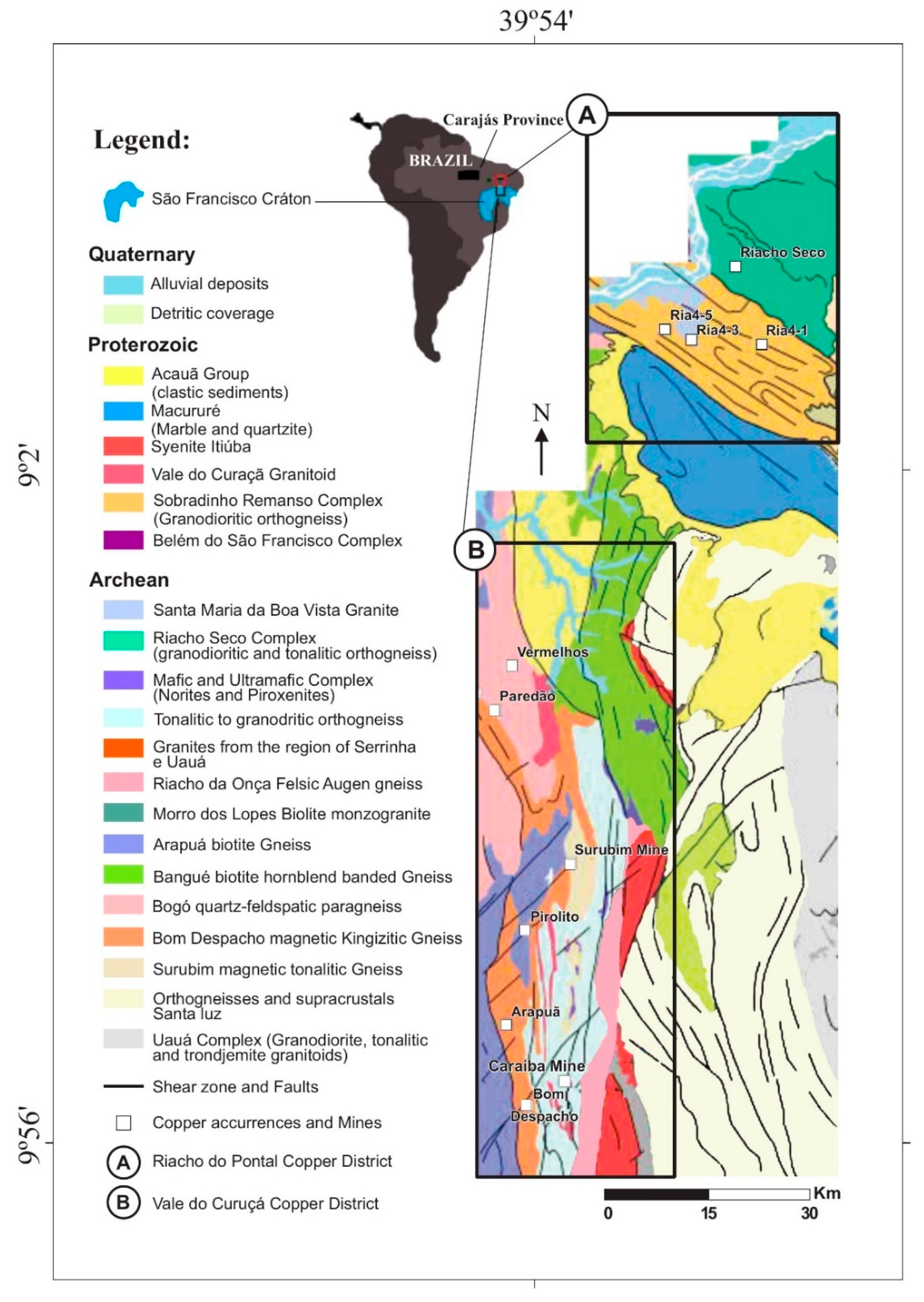
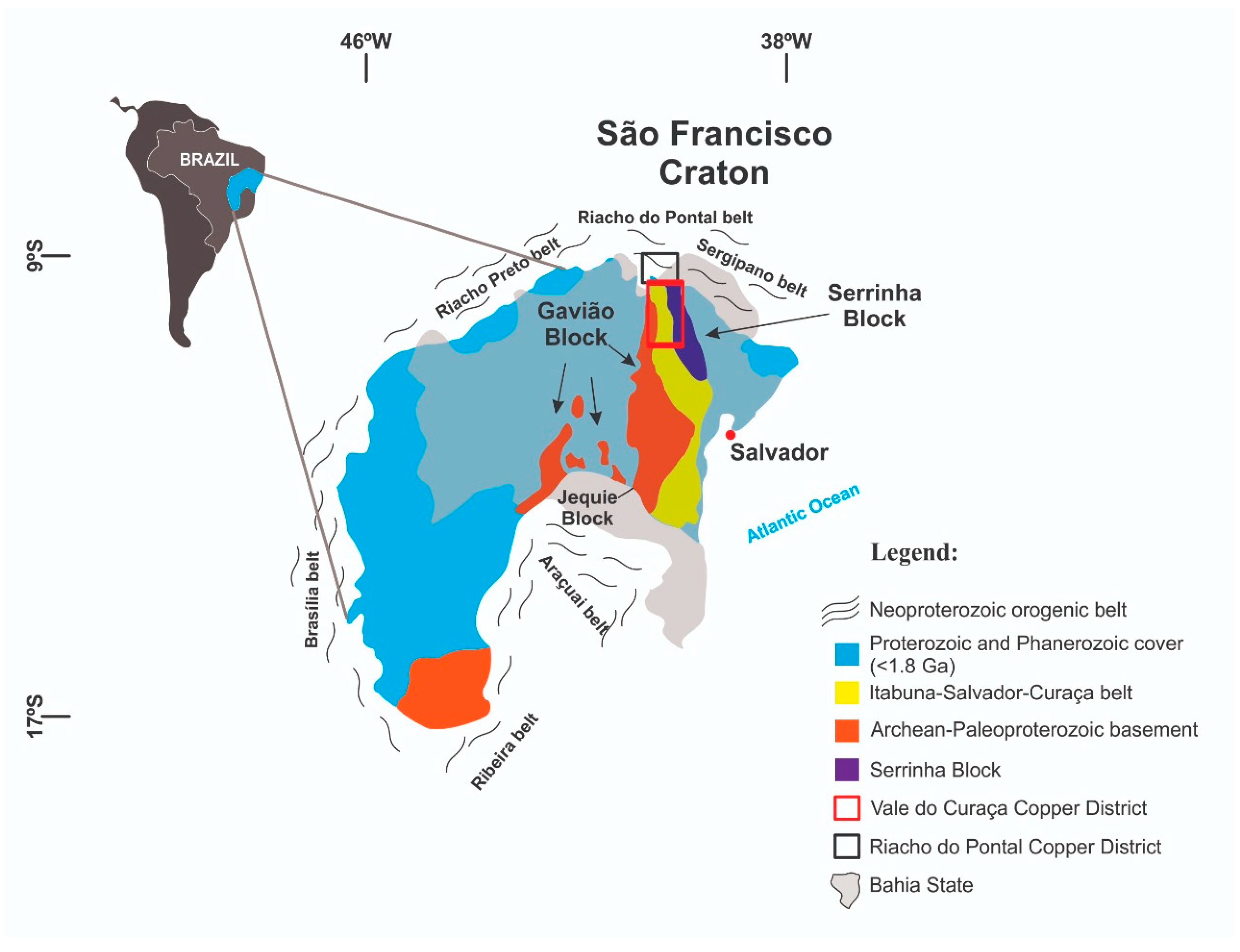


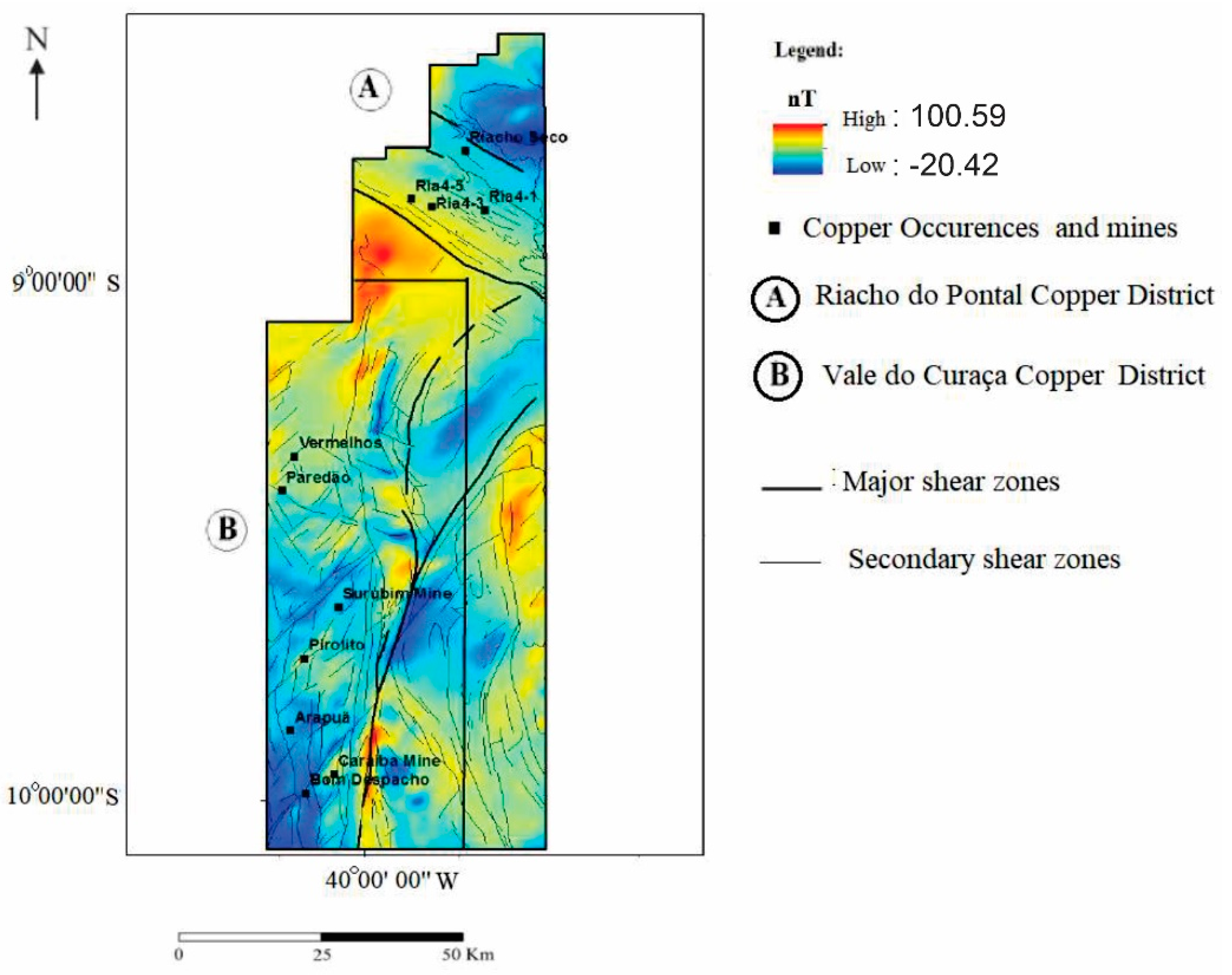
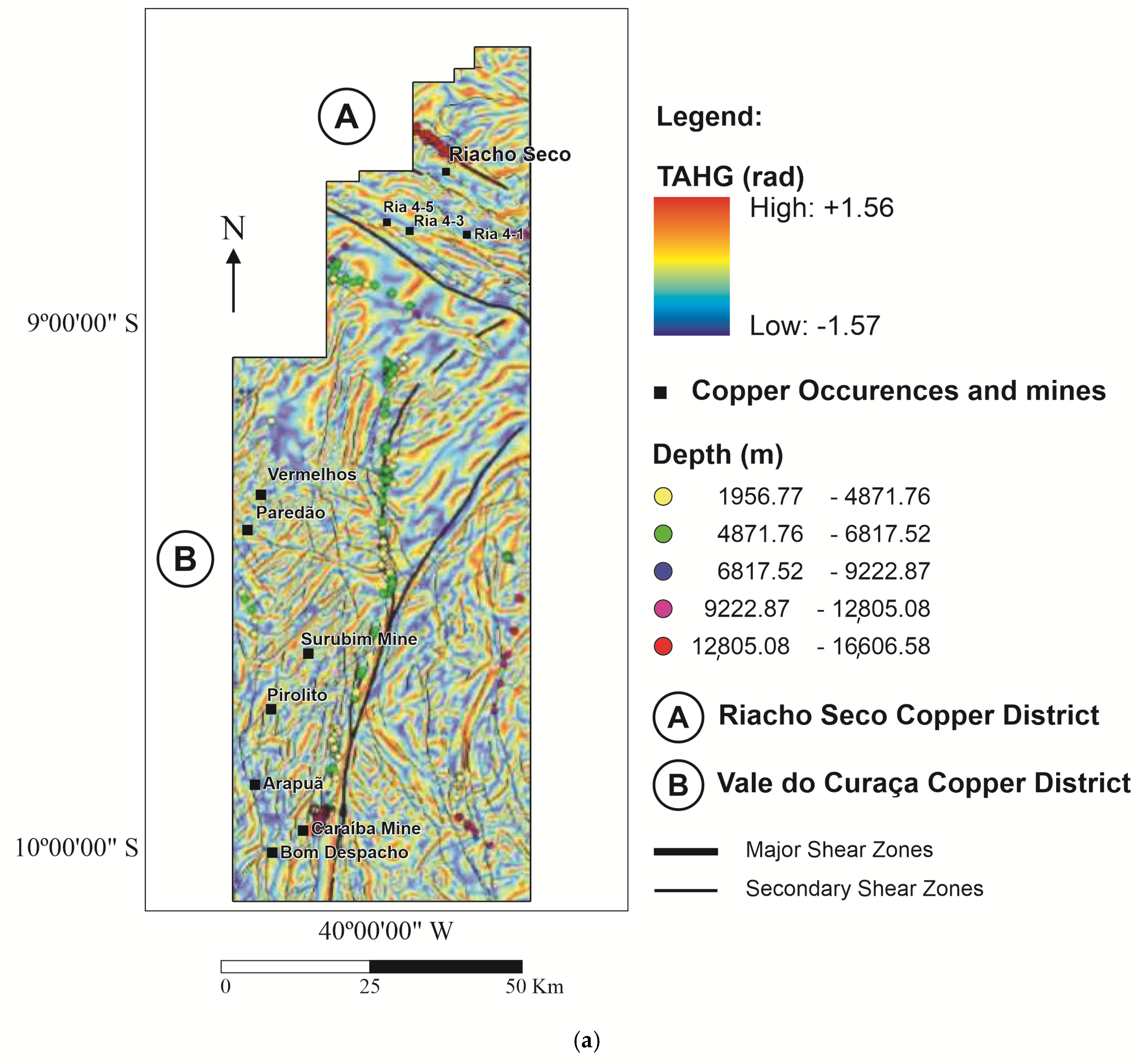


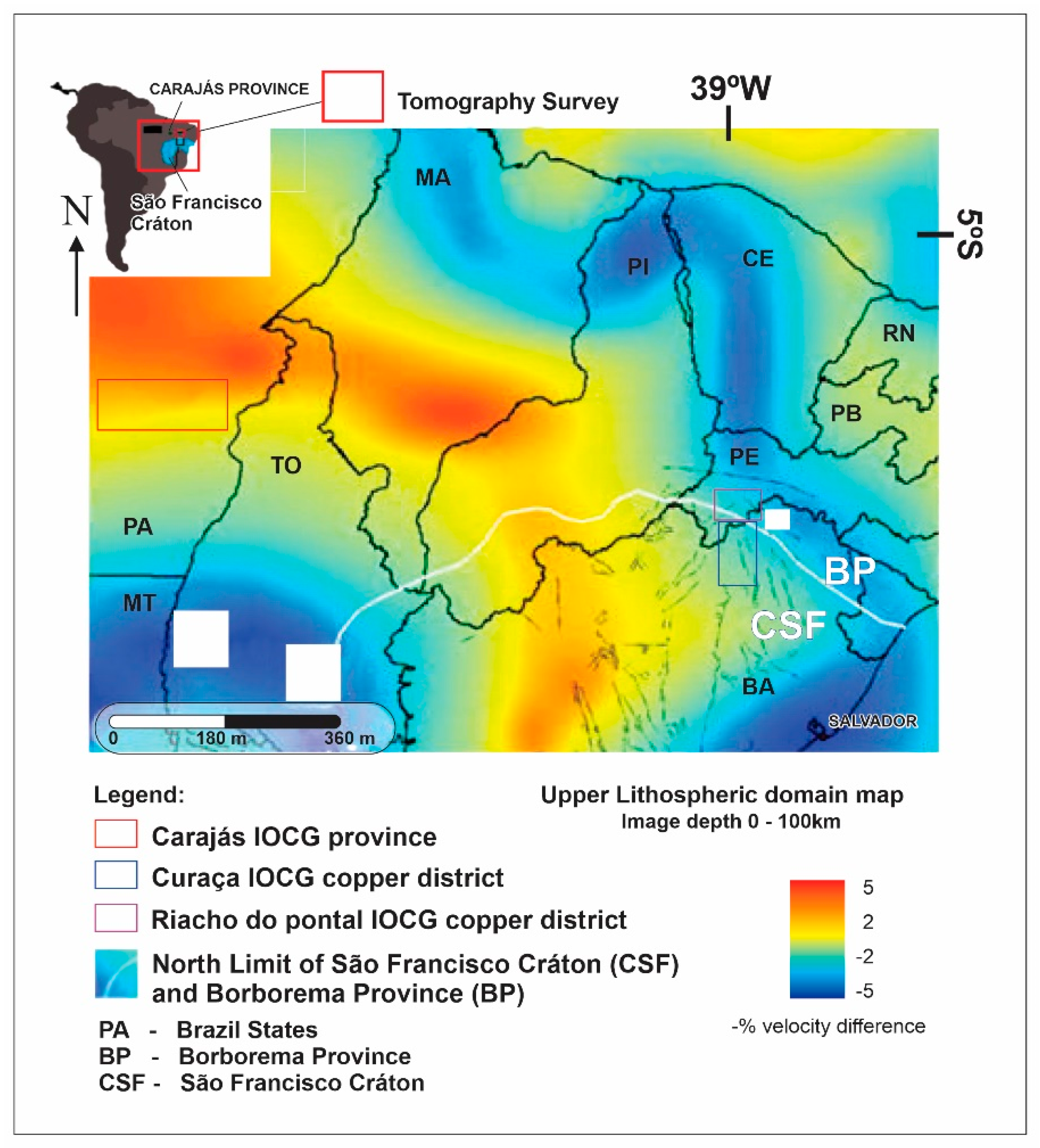

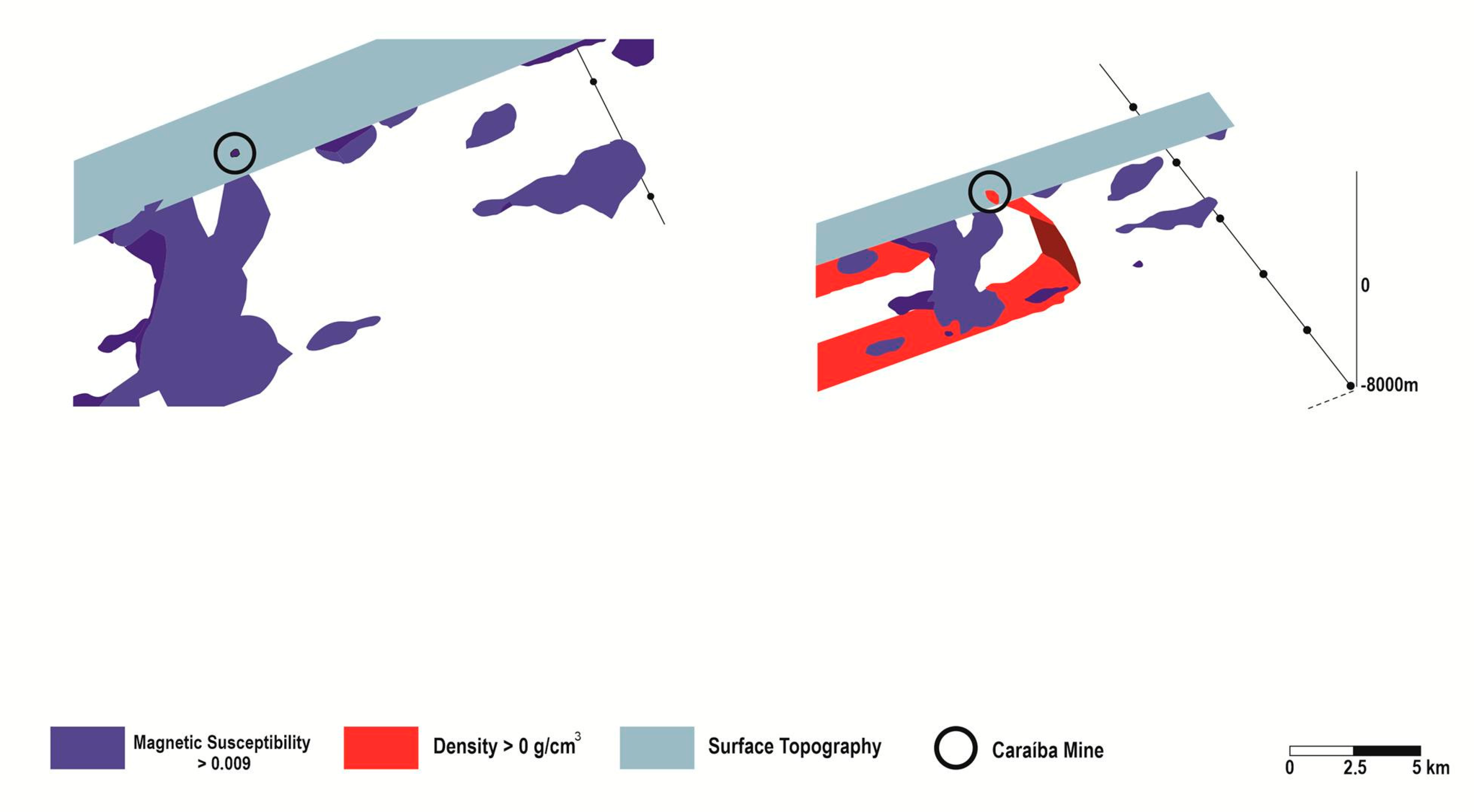



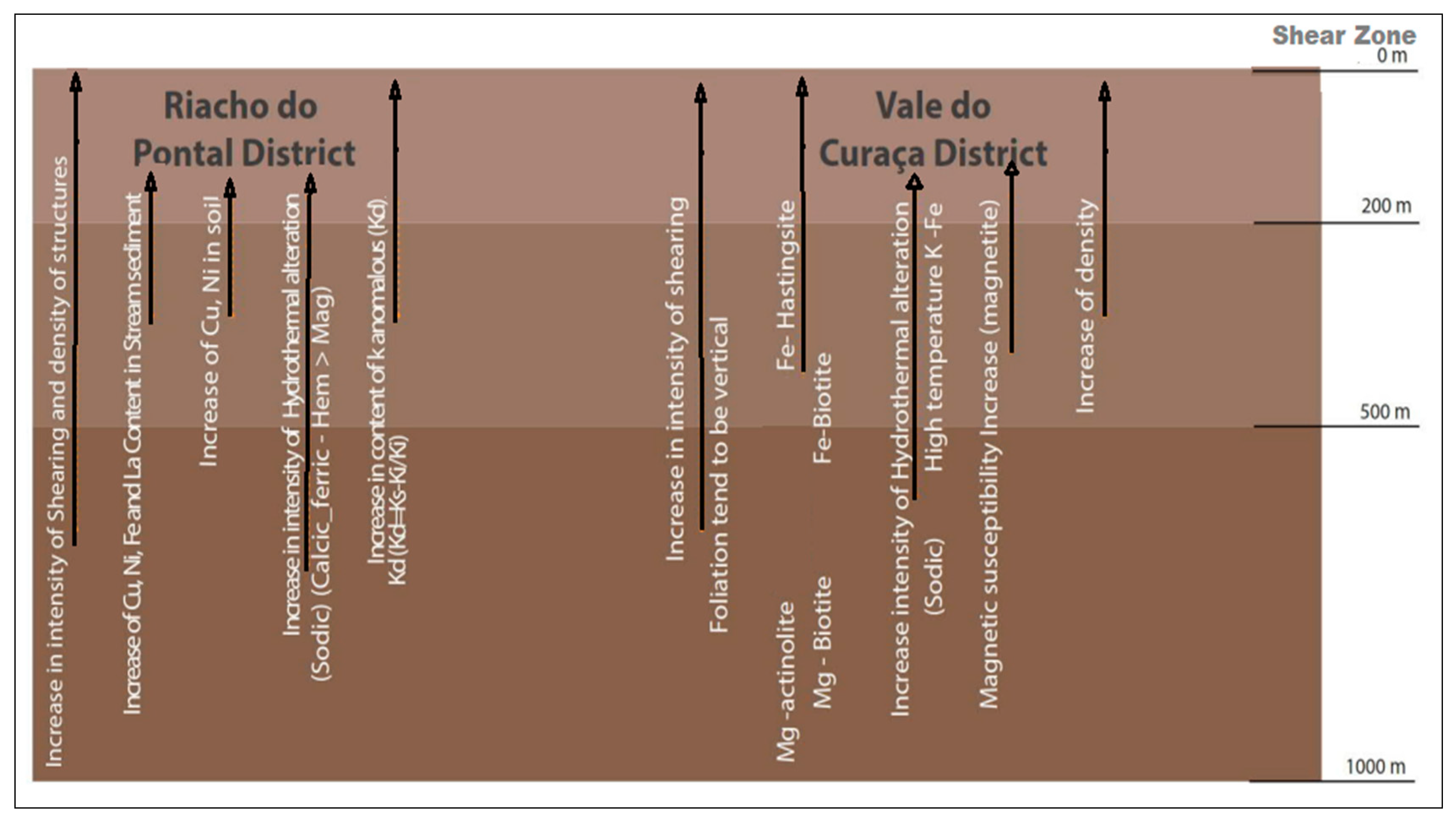
| PCB-RIA4-DH01 | Depth (m) | Rock Type | PCB-RIA4-DH02 | Depth (m) | Rock Type |
|---|---|---|---|---|---|
| PETRO-01 | 1.85 | Quartz-magnetite-biotite mylonite | PETRO-21 | 2.75 | Amphibole biotite gneiss |
| PETRO-02 | 5.50 | Quartz vein | PETRO-22 | 10.60 | Quartz vein |
| PETRO-03 | 8.70 | Biotite mylonite | PETRO-23 | 14.30 | Quartz vein |
| PETRO-04 | 10.70 | Biotite mylonite | PETRO-24 | 26.30 | Quartz vein |
| PETRO-05 | 13.00 | Biotite mylonite | PETRO-25 | 31.80 | Quartz vein |
| PETRO-06 | 21.00 | Biotite mylonite | PETRO-26 | 45.69 | Quartz vein |
| PETRO-07 | 25.50 | Biotite mylonite | PETRO-27 | 60.00 | Quartz vein. |
| PETRO-08 | 32.48 | Quartz biotite gneiss | PETRO-28 | 73.10 | Biotite quartz vein. |
| PETRO-09 | 67.70 | Quartz biotite gneiss | PETRO-29 | 83.60 | Quartz vein |
| PETRO-10 | 105.30 | Quartz biotite gneiss | PETRO-30 | 103.50 | Quartz vein. |
| PETRO-11 | 158.00 | Quartz biotite gneiss | PETRO-31 | 137.00 | Biotite quartz gneiss. |
| PETRO-12 | 167.80 | Quartz biotite gneiss | PETRO-32 | 148.80 | Biotite quartz gneiss |
| PETRO-13 | 173.60 | Quartz biotite gneiss | PETRO-33 | 168.10 | Biotite mylonite |
| PETRO-14 | 189.00 | Quartz biotite gneiss | PETRO-34 | 265.10 | Biotite quartz gneiss |
Publisher’s Note: MDPI stays neutral with regard to jurisdictional claims in published maps and institutional affiliations. |
© 2020 by the authors. Licensee MDPI, Basel, Switzerland. This article is an open access article distributed under the terms and conditions of the Creative Commons Attribution (CC BY) license (http://creativecommons.org/licenses/by/4.0/).
Share and Cite
Hühn, S.R.B.; Silva, A.M.; Ferreira, F.J.F.; Braitenberg, C. Mapping New IOCG Mineral Systems in Brazil: The Vale do Curaçá and Riacho do Pontal Copper Districts. Minerals 2020, 10, 1074. https://doi.org/10.3390/min10121074
Hühn SRB, Silva AM, Ferreira FJF, Braitenberg C. Mapping New IOCG Mineral Systems in Brazil: The Vale do Curaçá and Riacho do Pontal Copper Districts. Minerals. 2020; 10(12):1074. https://doi.org/10.3390/min10121074
Chicago/Turabian StyleHühn, Sérgio Roberto Bacelar, Adalene Moreira Silva, Francisco José Fonseca Ferreira, and Carla Braitenberg. 2020. "Mapping New IOCG Mineral Systems in Brazil: The Vale do Curaçá and Riacho do Pontal Copper Districts" Minerals 10, no. 12: 1074. https://doi.org/10.3390/min10121074
APA StyleHühn, S. R. B., Silva, A. M., Ferreira, F. J. F., & Braitenberg, C. (2020). Mapping New IOCG Mineral Systems in Brazil: The Vale do Curaçá and Riacho do Pontal Copper Districts. Minerals, 10(12), 1074. https://doi.org/10.3390/min10121074








